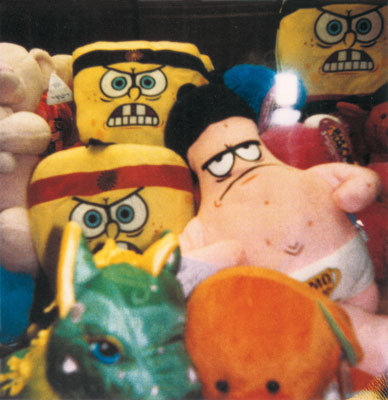Cy Twombly
dal 5/4/2011 al 9/7/2011
Segnalato da
5/4/2011
Cy Twombly
Museum Brandhorst, Munich
Photographs 1951-2010. A selection of circa 120 photographs covering sixty years of his career is now reveal the artist's special approach and the creative range of this oeuvre. Besides flower still-lifes and landscapes it is views of his studio that captivate.

Munich, 23 March 2011 | Cy Twombly has gained international recognition first and
foremost through his paintings and drawings. It was not until the 1980s that he
publically exhibited his hitherto unknown sculptural works. The artist's
photographic oeuvre followed in early 1990s, initially in gallery exhibitions and
various publications. It took until the summer of 2009 for all of the art forms
explored by the artist to be united in a retrospective at the Museum moderner Kunst
Stiftung Ludwig (MUMOK) in Vienna, at which time numerous parallels in the
media-related development became discernable: Twombly drew on his canvases, made use
of oil colors on paper, painted his white plaster sculptures, and, with his photos,
made reference to his own art, as well as his experiential and empirical
environment. According to Twombly, this spectrum embodies the various "states of
mind" of his creative output.
Now, for the first time in Germany, the Museum Brandhorst is presenting over 100 of
the artist's photographic works. In addition to flower still-lifes and landscapes,
Twombly's photographs of his studio clearly reveal the artist's preferred lighting
and atmosphere for this medium. The most striking feature of these works is their
blurriness - a not unintentional nod to the pictorialists of the late 19th century.
The loss of motif-related clarity is, however, counterbalanced by a gain in
pictorial presence. Moreover, all images have been intentionally overexposed,
leading to the disintegration of the subjects' material integrity. A photoflash
occasionally creates a flare spot over the objects, providing them with a bleached
out effect. The replication achieved with drypoint additionally endows the works
with a soft, perplexing quality.
All of these moments, which might be considered unsuccessful or flawed in a
professional sense, soften the contours of what has been depicted, melt substances
and forms, allow light and shadow to become mutually indistinct, and remove the
radiance of colors and/or intensify their power. A feeling of sentimentality or
kitsch, however, does not arise. A strict concept underlying the work becomes
particularly noticeable: a concept that, in the still-lifes and studio photographs,
is nearly constructivist owing to the copious cultural and art historical
references; and, in the flower and tree works, that can be appreciated as a playful
adaptation of Art Informel and/or monochromatic painting. All in all, the viewer is
left with the impression that the artist, via the medium of photography, is
reflecting on that which he has actually manifested in his body of paintings.
So-called reality dissolves each time in an abundance of aggregate states: that
which remains from the drawings is the gestural quality of their composition, from
the message only a vague memory, the here-and-now interspersed with mythical
moments, the factual subjected to permanent transformation. In all of the media -
whether painting, drawing, sculpture or photography - Twombly offers the viewer no
intrinsically coherent messages which can be formally, iconographically or - in a
historical sense - stylistically concisely determined or analytically defined. The
artist's oeuvre can, on the contrary, be generally understood as an invitation for
viewers to come up with their own sensorial and significative context from the
floating phenomena. This amounts to a process that encompasses and touches on a
great deal, which offers much, yet barely leads to definitive classifications and
determinations.
The upper floor of the Museum Brandhorst contains an extensive collection of
paintings, sculptures and works on paper by Cy Twombly, unrivalled in all of Europe.
For reasons of conservation, however, the artist's photographic works cannot be
integrated into this context, but will be shown in the galleries on the lower floor,
where they are not exposed to daylight. Visitors will of course have the opportunity
to travel between the upper and lower floors to appreciate the motif-related
correlations and media-related differences. This provides insight into a body of
work that is singular and yet contains numerous intriguing potential correlations to
other working methods in contemporary photography, as embodied by, among others,
Hiroshi Sugimoto, Gerhard Richter and Elger Esser.
Image: Cy Twombly, Wall Mart, 2007
Dr. Christine Kramer
Press Officer
Department & Communication
Bayerische Staatsgemäldesammlungen
Museum Brandhorst
Theresienstraße 35 a
D 80333 Munich
Tel. +49 (0)89 23805-1320
Email: presse@museum-brandhorst.de
www.museum-brandhorst.de
Tine Nehler M.A.
Head of Press
Bayerische Staatsgemäldesammlungen
Pinakothek der Moderne
Barer Straße 29
D 80799 Munich
Tel. +49 (0)89 23805-1321
Email: presse@pinakothek.de
Press conference: 06.04.2011 h 11.00
Opening: 06.04.2011 h 18.30
Museum Brandhorst
Theresienstrasse 35a - Munich
Gallery hours:
Daily except MO 10.00 - 18.00
THU 10.00 - 20.00
Admission:
Regular admission 7 € | Concessions 5 €
Sunday admission 1 €



